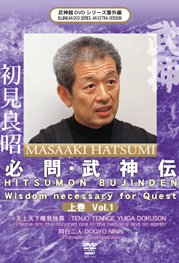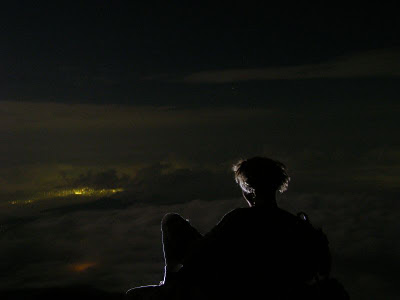From 自然行雲流水 by 自然行雲流水

Henka derives from your Kihon. If your Henka is not working, go back to the Kihon. How many people do this? The Shihan move with structure in their henka. They have left the forms of the original kata but, use the structure and principals within them. When Soke says that you don`t need the forms,kamae etc, he is talking to the people that have done them for many years. The 15th dans he says. Don`t try and rush in and understand Sokes movements etc. Train according to your rank. Even if you attend classes with details on subtleties in the taijutsu, are you really capable of understanding them? Are you at a point in your training that you can integrate these subtleties? It`s like trying to run before you can walk.
Don`t neglect the forms and kata of the Bujinkan. You will learn the process of training and come to understand the concept of Shu Ha Ri naturally from experience, not just from reading or being told about it.
Soke and all of the Shihan have, and still do, revolve their training around the structure learned from kihon and waza of the Bujinkan Ryuha. You can see it. The Shihans level of taijutsu is a result of training correctly for many years. But, it seems in this era, everyone is trying to jump forward a few decades of training to do what is being taught at the Hombu. This is not possible. People need to wake up and think about where they truly are. Remember, the Bujinkan ranks are Sakizuke. The Bujinkan is alive due to this. Other arts that have set standards ( regardless if they become skilled quicker in technique ) create people with boundaries and minds set in form. This is dangerous.
I`d like to say that the Bujinkan Dojo has developed vastly. The Bujinkan is natural and it`s showing this throughout the world. Just like mother nature, the Bujinkan is growing and developing freely. This is as it should be, I feel.
There are no shortcuts. There is only constant self re-evaluation through correct training in body,mind and technique.
The more you train and really get honest with yourself, you will see where you truly stand in actual skill level. This is very confronting and, many people dare tread there I feel. After generating a reputation, people feel they have to protect it or, they will lose students. They cannot look like they do not know something in front of their students. This is the end for them really.
It is important to understand your shortcomings and train accordingly. In fact, I think the more you come to terms with your place in the dojo, you will become lighter and enjoy training more with a renewed focus and knowing that your own shugyou is all that matters.
To know, is really to learn that you don`t know. This keeps the heart on track and the mind on correct training. The more I train in the kihon, the more I become aware of and develop a more in depth appreciation of the lessons that kata, kamae, and the principals offer. You also naturally come to gain a better appreciation of history, culture and the Japanese lifestyle. If you put too much of your own thoughts and desires into the training, you will push these learning opportunities away and move toward your own way or style. If this is the case, don`t call what you do Bujinkan and leave.
Nagato Shihan said to me that people around the world are teaching to use "no power" too early. He said, people are too soft and have not learned how to form correct kamae, blocks,strikes,kicks etc.
People are training in a lazy way. If you neglect the foundations, your future training will suffer greatly and, so will your students. Even if you are small, a woman, or have a weaker constitution, correct training in technique in conjunction with an understanding of the principles etc, will allow you to apply self defense. Remember, we are learning an art form. Everyone needs to understand that just like in Aikido,Judo,Karate Do etc, all the students need to follow the same path. If you cannot accept this. don`t begin training. It is only after a certain ability has been attained that you can start training with more of your own face. This time in the Bujinkan is when one reaches the level of Godan.
Before godan, the student trains hard and does what the teachers says.
Do not make excuses for your lack of training.
Our training is Shin Gi Tai training. We practice to develop these three essential points and unify them. This is the ultimate goal of bugeisha, according to Soke. We can also view this as a Sanshin. Therefore understanding and maintaining the heart of a three year old that lasts for a hundred years.
People say Budo is not about power or strength. That is true. But, it is about strength and power from correct body alignment and technique. It is true that with correct technique, the power will come.
Do not concentrate on power, concentrate on technique, your spirit, and your body. With endurance and focused training over many years, we all may come to have skills like the Shihan. However, if we just blindly follow them without knowing our true level, it will be detrimental to our development.
You have to have the ability to discern.
The Shihan and Soke are just training. This is all they do. They are not teaching. Don`t go to Japan and think you will be taught.
There are people here that tell you they know, and many people are attracted to that. Be careful. Often they are just good talkers. The proof is in the pudding. The art of observation is very important as is the ability to read the atmosphere of the moment or "Kuuki Yomu."
There is much happening in the dojo. If you are not open or have an overflowing teacup, you will miss a lot.
The only way to understand this art is to experience both sides of training. That is, the side of Uke and the side of Tori. Both equal %50. Therefore, together you are recieving %100 training. If you cannot be an uke, you really can only learn %50 of the martial arts. If your ego won`t allow you to give yourself, then you will not learn. Training is about understanding your spirit and Rokkon Shojou: the art of purifying your senses.
Thoughts on a cold winters morning.
南虎
…










